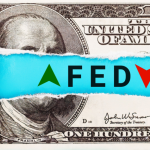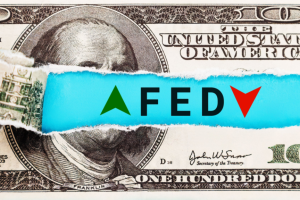
During the most recent FOMC meeting, Federal Reserve officials, as per the released minutes, showed reluctance to consider interest rate cuts in the near future. That’s largely due to persistent concerns about inflation surpassing their target. Fed officials remain cautious, suggesting potential future measures to address inflationary challenges.
FOMC members emphasized the necessity of maintaining a “restrictive” monetary policy until clear evidence indicates a sustained return of inflation to the central bank’s 2% target, as highlighted in the meeting minutes.
As mentioned, the minutes indicated a cautious tone, suggesting decisions will be made based on comprehensive incoming information and its impact on the economic outlook and risk balance. Market sentiment continues to lean heavily towards the belief that the Fed has concluded rate hikes, with expectations of potential cuts beginning in May and four quarter-point cuts by the end of 2024.
But is that the case? Let’s dive in.
No Discussion About Cuts
The minutes did not suggest any discussion among members about potential rate cuts, a sentiment echoed by Chairman Jerome Powell in his post-meeting news conference. Powell explicitly stated as much in his press conference, suggesting the committee is not currently considering rate cuts. The current federal funds rate stands at 5.25% to 5.5%, the highest in 22 years.
The meeting addressed concerns about increasing Treasury yields, which were extensively discussed. Following the meeting, yields, which had reached 16-year highs, retreated as markets evaluated the impact of substantial government borrowing. Policymakers attributed the rise in yields to growing term premiums, influenced by increased supply due to significant budget deficits. The minutes highlighted the importance of closely monitoring market developments due to potential implications for monetary policy.
Risks Create Caution
In October, consumer prices remained stagnant, signaling a slowdown in inflation. Thus, the Fed’s focus shifted towards deciding how long to maintain the policy rate in the current range. The minutes highlighted a potential need for further tightening if progress toward the inflation objective was insufficient, indicating a nuanced approach. That statement differed from the September meeting, where a majority anticipated another rate increase in the ongoing tightening cycle.
The recent policy meeting affirmed the decision to maintain the current rate setting, awaiting clarification at the Dec. 12-13 meeting. Financial markets remained relatively unchanged, reinforcing the perception that the Fed has paused rate hikes. Market indicators suggested increased expectations of a rate cut in the April 2024 meeting. U.S. stocks slightly declined, the U.S. dollar strengthened, and U.S. Treasury yields dipped after the minutes’ release.
The minutes revealed that U.S. central bank officials grappled with conflicting economic signals, acknowledging the economy’s more two-sided risks. Despite robust 4.9% Q3 economic growth, concerns emerged over elevated inflation and tightening financial conditions, prompting a cautious commitment to maintaining a restrictive policy stance until inflation shows sustained decline. The overall tone of the FOMC minutes leaned cautiously hawkish, emphasizing the need for vigilance.
Economic Growth Will Likely Slow
Officials anticipated a significant slowdown in economic growth in Q4, acknowledging downside risks to overall economic growth and upside risks to inflation. They recognized the current policy as restrictive, exerting downward pressure on economic activity and inflation. Opinions within the Fed varied on whether to maintain the current stance or consider additional rate increases.
Economic data presented a mixed picture, with generally positive trends in inflation. The personal consumption expenditures price index, a key inflation indicator, revealed a 3.7% 12-month pace in September, a notable improvement from May but still above the Feds target. Some economists expressed concerns about the challenge of reducing inflation, given strong wage increases and elevated components like rent and medical care, with sticky prices rising by 4.9% over the past year.
Despite a robust job market showing signs of moderation, with a modest increase of 150,000 nonfarm payrolls in October and a rise in the unemployment rate to 3.9%, there are concerns about a potential economic slowdown. The half-percentage-point increase in the jobless rate is often associated with recessions. Despite a strong start in 2023, economic growth is expected to significantly slow, with the Atlanta Fed’s GDPNow tracker indicating a 2% growth in the fourth quarter.
Inflation Is Still Probable
During his press conference, Jerome Powell emphasized caution in managing the delicate balance between addressing persistent inflation and avoiding economic harm. The Fed’s cautious approach may yield unexpected positive outcomes, as a New York Fed study suggested the delayed interest rate hikes allowed the economy to achieve growth while effectively addressing inflation.
Policymakers, led by Powell, are cautious about declaring victory over inflation and providing explicit guidance to investors. Powell emphasized the need for careful navigation, considering the risk of misinterpretation and the potential harm of overly aggressive tightening measures.
On the date of publication, Chris MacDonald did not hold (either directly or indirectly) any positions in the securities mentioned in this article. The opinions expressed in this article are those of the writer, subject to the InvestorPlace.com Publishing Guidelines.








